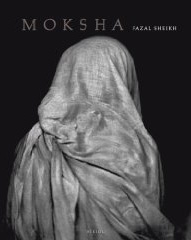Moksha.
Photographs by Fazal Sheikh.
Steidl, Gottingen, 2005. 220 pp., 170 tritone illustrations, 10½x13″.
Not many photogra phers can handle both politically and culturally sensitive topics with such understanding and respect as Fazal Sheikh. He considers himself an artist-activist and since 1992, with a Fulbright to Kenya, Sheikh has dedicated his photographic life to highlighting the plight of displaced peoples in order to spread awareness on a global level. He has lived in refugee camps in East Africa collaborating with displaced communities from the Horn of Africa to Mozambique, resulting in the books A Sense of Common Ground and A Camel for the Son. He has followed his grandfather’s roots to northern Pakistan and given a voice to Afghan refugees in his 1998 book The Victor Weeps. In creating Moksha, he lived among dispossessed widows in northern India. In this latest book, Sheikh combines portraits, testimonials, cultural details and history to present a holistic view of the women of Vrindavan. The mood and spirituality of this holy city permeate the pages with his soft-focus and fog-saturated black-and-white images. The ritual of turning each page, looking at each portrait, reading each personal history, is meditative. The reason these women live in Vrindavan, though, is societal marginalization. Once widowed, and cast out by their own families, they seek refuge in Vrindavan only to survive by chanting at the temples for a charitable donation or begging on the streets. These women are resolute, devoting themselves to Krishna in hopes of being released from their misery and the cycle of reincarnation, to reach a higher state in the afterlife called “moksha.” Sheikh has been lauded with many awards, and rightly so. Just last year he was named a MacArthur Fellow. Education is power and that is part of Sheikh’s vision with his International Human Rights series. In addition to reaching those who can make a difference, he also seeks to enlighten the citizens within the countries of displaced peoples. He does this by making material available online and by including text in the languages of the respective communities. In Moksha there is a separate insert with translations in Hindi and Bengali. Time and again, with each project, Sheikh produces beautiful and moving images that make a lasting impression and leave one both pensive and solemn. – Larissa Leclair
phers can handle both politically and culturally sensitive topics with such understanding and respect as Fazal Sheikh. He considers himself an artist-activist and since 1992, with a Fulbright to Kenya, Sheikh has dedicated his photographic life to highlighting the plight of displaced peoples in order to spread awareness on a global level. He has lived in refugee camps in East Africa collaborating with displaced communities from the Horn of Africa to Mozambique, resulting in the books A Sense of Common Ground and A Camel for the Son. He has followed his grandfather’s roots to northern Pakistan and given a voice to Afghan refugees in his 1998 book The Victor Weeps. In creating Moksha, he lived among dispossessed widows in northern India. In this latest book, Sheikh combines portraits, testimonials, cultural details and history to present a holistic view of the women of Vrindavan. The mood and spirituality of this holy city permeate the pages with his soft-focus and fog-saturated black-and-white images. The ritual of turning each page, looking at each portrait, reading each personal history, is meditative. The reason these women live in Vrindavan, though, is societal marginalization. Once widowed, and cast out by their own families, they seek refuge in Vrindavan only to survive by chanting at the temples for a charitable donation or begging on the streets. These women are resolute, devoting themselves to Krishna in hopes of being released from their misery and the cycle of reincarnation, to reach a higher state in the afterlife called “moksha.” Sheikh has been lauded with many awards, and rightly so. Just last year he was named a MacArthur Fellow. Education is power and that is part of Sheikh’s vision with his International Human Rights series. In addition to reaching those who can make a difference, he also seeks to enlighten the citizens within the countries of displaced peoples. He does this by making material available online and by including text in the languages of the respective communities. In Moksha there is a separate insert with translations in Hindi and Bengali. Time and again, with each project, Sheikh produces beautiful and moving images that make a lasting impression and leave one both pensive and solemn. – Larissa Leclair
Originally published in the Photo-eye Booklist, Spring 2006.
